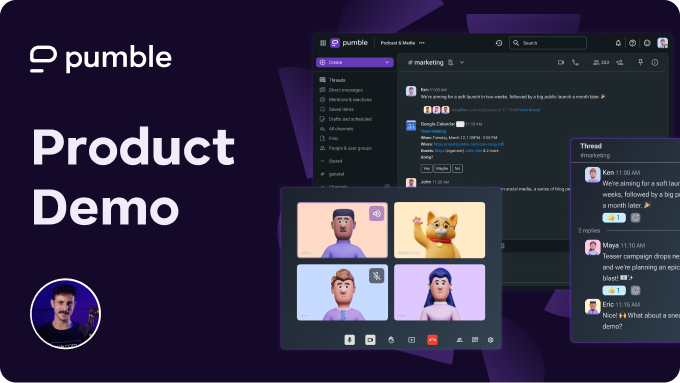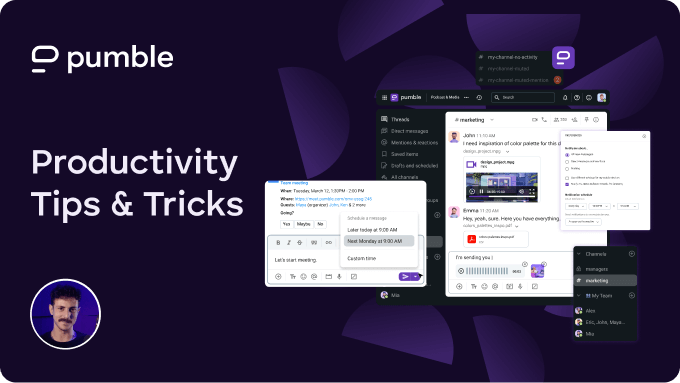Table of Contents
How much does Slack cost?
Slack offers both free and paid subscription plans.
The 4 Slack pricing tiers include:
- Free,
- Pro ($8.75 user/month),
- Business+ ($18 user/month), and
- Enterprise+ (quoted separately upon request).
Let’s take a look at the table below to get a brief breakdown of Slack plans.
| Free | Pro | Business+ | Enterprise+ |
|---|---|---|---|
| $0 |
$8.75 per month per user, billed monthly |
$18 per month per user, billed monthly |
Upon request |
| Most recent 90 days of message history |
Unlimited search |
Data exports for all messages |
Employee directory |
| 1:1 audio and video calls |
Audio and video calls for up to 50 participants |
SAML-based SSO |
Custom templates |
| Up to 10 app integrations |
Unlimited app integrations |
99.99% guaranteed uptime SLA |
24/7 priority support with 4-hr first response time |
The Free plan offers a limited experience with restricted searchable message history, only 2 people per video call, and limited storage.
Unlimited searchable messages, group screen sharing, unlimited third-party app integrations, and other more advanced features are available with premium subscriptions.
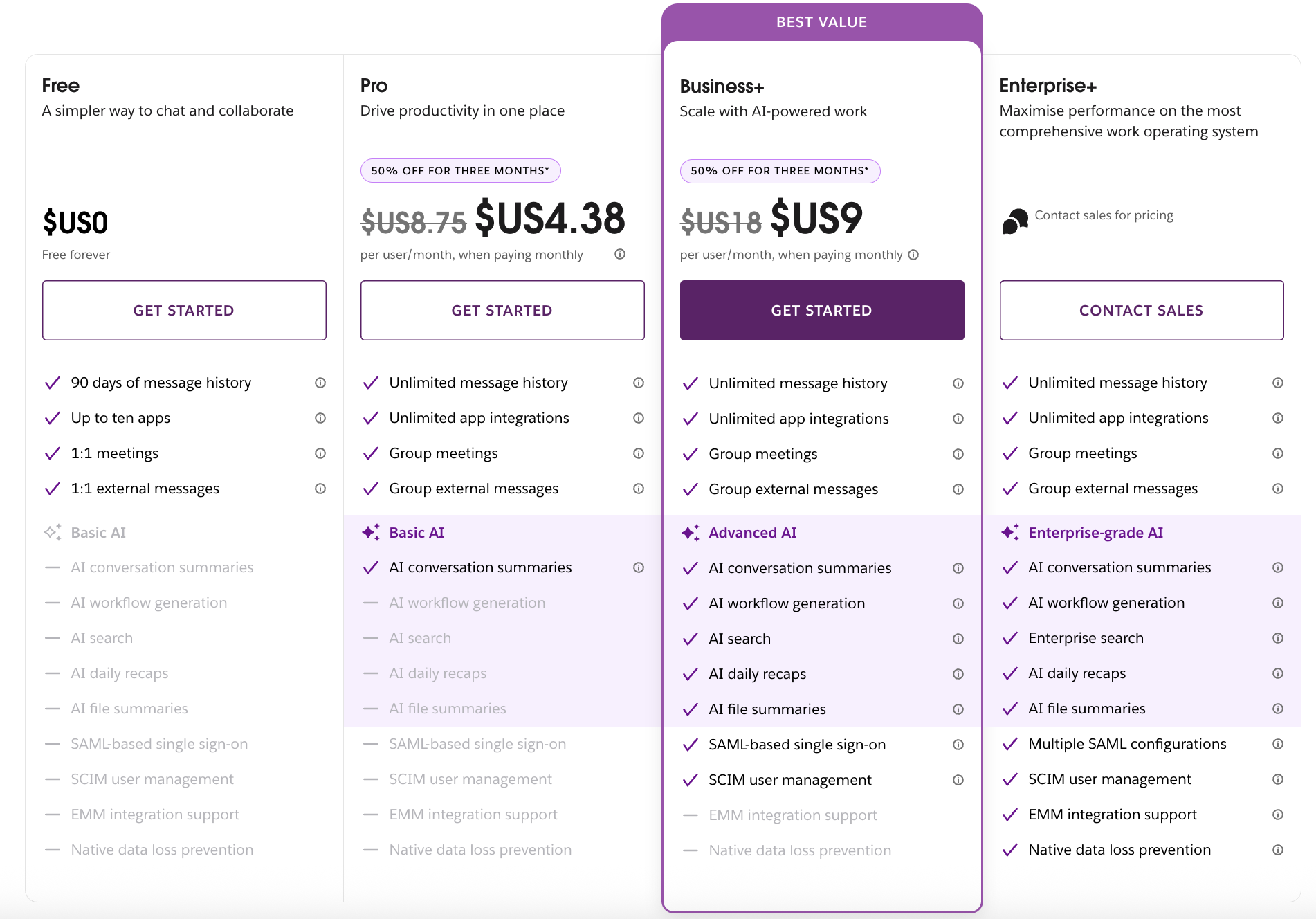
Let’s explore in greater detail all Slack’s plans have to offer — by breaking down each tier.
Slack Free plan features and limitations
Slack has had a freemium strategy since its debut.
However, the Free plan offers only basic functionality with significant limits.
With the Slack’s Free plan, you can:
- Collaborate in Slack canvases (in DMs and channels only),
- Have 1:1 video and audio calls,
- Integrate up to 10 of your favorite apps, and
- Search the most recent 90 days of your message history and file storage.
Free plan users can send audio and video in direct messages and channels. This gives teams the freedom to have asynchronous updates and reduces the amount of meetings needed.
Still, Slack’s Free plan seems far from suitable for any substantial professional team communication.
There are specific limitations in Slack’s Free plan that may be dealbreakers for most teams.
Let’s explore these in more detail.
Limitation #1: Limited message history
Although the Free version includes some core Slack features, it only allows access to messages from the most recent 90 days.
This means that you can’t find any older messages and files even in your workspace search results, as they’re gone for good to make room for new ones. So, for example, if you happen to need some data from 4 or 6 months ago, you won’t be able to retrieve it, which is a major downside.
Furthermore, in June 2024, Slack updated its policy for free workspaces: starting August 26, 2024, messages, files, and other content older than one year are being permanently deleted on a rolling basis.
Limitation #2: Up to 10 third-party integrations
Workspaces with the Free subscription plan are limited to 10 applications.
Slack's Free version doesn’t provide unlimited access to all third-party apps.
You need to upgrade your workspace or delete some of your current applications if you want to add new apps on Slack’s Free plan.
Limitation #3: One-on-one video calls
If you're on the Free plan, you can kiss the team meetings or conferences goodbye. While Slack supports the audio/video capability, in the Free plan, you can only communicate with one person at a time.
You'll need to upgrade to one of Slack's paid plans if you want to virtually meet with more than one person at a time.
Still, Slack limits you to only 50 participants per meeting on all paid plans, which can be a deal breaker for mid-sized to large teams relying on effective team collaboration to get their best job done.
This limitation is especially significant if we consider the higher-end pricing Slack charges, which doesn't always reflect the value you can get for that amount of money.
Limitation #4: File storage
Free Slack users also have to deal with a 90-day limitation on their file storage.
After that, Slack archives older files to make space for new ones. Archived files aren’t deleted — they’re just hidden from search results, messages, and channels.
If you upgrade to a paid plan, archived files will become visible again.
However, if a file is manually deleted, it’s permanently removed and can’t be recovered, even after upgrading. Deleted files also aren’t included in any data export.
—
All in all, the Free Slack version basically offers a sneak peek at its core functionality, but any substantial communication requires switching to a paid plan. It might be a great choice for freelancers and individual users, though — if you don’t mind limited message history and integrations.
Slack Pro plan features and limitations
The Pro plan is an upgrade from the Free plan meant for small and medium-sized businesses.
Even though it removes most of the limitations from the Free tier, at $8.75 per user per month, it is on the pricier side, which essentially overrides any benefits.
Features included in the Slack Pro plan are:
- Unlimited message history,
- Unlimited app integrations,
- Group meetings with up to 50 people,
- Group external messages, and
- Slack Huddles, which lets you start a live voice or video conversation in a channel or direct message.
You also gain access to 24/7 customer support — not a priority version, though.
So, it isn't the entire Slack package yet, but it has many useful features.
For many businesses, though, the cost is a significant investment — and many don’t find the high-end pricing justified — so bear that in mind when considering upgrading your Slack account.
Slack Business+ plan features and limitations
The next Slack paid plan in line is Business+.
On June 17, 2025, monthly Slack Business+ plans increased from $15 to $18 per user per month.
Benefits of the Slack Business+ plan include:
- Advanced identity management through SAML-based SSO,
- Compliance requirements met with data exports for all messages, and
- Around-the-clock support and assistance with 99.99% guaranteed uptime and 24/7 support with a 4-hour response time.
When you subscribe to the Business+ plan, you have access to extra services such as guaranteed 99.99% uptime SLA. This means that you’ll be refunded if Slack's servers are down for an extended length of time.
The Business+ plan also gives you access to message activity analytics to help you keep track of your internal communications campaigns.
However, the pricing is one significant limitation of this plan. If you pay annually, the Business+ plan will cost you $15 per user per month — or $18 per user per month if you choose a monthly billing plan.
Slack Enterprise+ plan features and limitation
The Enterprise+ plan is best suited for large companies with hundreds or thousands of employees.
You can section your organization into smaller and more manageable Slack workspaces while maintaining a healthy cross-functional collaboration in shared channels.
The cost of Slack Enterprise+ varies depending on several criteria and is available upon request.
Enterprise+ plan comes with security and governance features that are non-negotiable in regulated industries like financial services and healthcare, as well as eDiscovery capabilities that are essential for in-house legal teams that need to gain access to files and conversations in Slack.
Some of the benefits of Slack’s Enterprise+ plan are:
- Unlimited workspaces,
- Easier administration for admins and users,
- Improved security,
- Allowed integration with Monitoring and Data Loss Prevention (DLP) solutions, and
- Archiving and Data Retention.
Businesses can use Slack Enterprise+ plan to construct communication systems with centralized control. The structure reflects the way your company operates. When needed, channels from multiple workspaces may be shared, and you can also interact with external partners.
Still, Slack caps its maximum meeting capacity at 50 participants even in its priciest plan, which is a significant limitation considering the cost.
Is Slack the right solution for you?
While admittedly a powerful tool, Slack is not an ideal fit for every team.
So, the question of whether or not Slack is the right solution for you ultimately boils down to your team and your specific needs.
The key downside for many, however, is its affordability — or lack thereof.
As an illustration, let’s say you run a medium-sized company with 100 employees, all of whom need to be on Slack to keep your internal communication effective and your business running smoothly. Moreover, you’ll have to purchase at least the first-tier paid plan — Pro, at $8.75 per user per month — to keep your basic collaboration in check with unlimited message history and group audio and video meetings.
In that case, your monthly Slack costs will amount to a whopping $875 ($10,500 per year), or $725 ($8,700 per year) if you opt for the annual subscription. If you have a larger staff of, for example, 1000 team members, the yearly Slack price ($105,000) will undoubtedly have a significant impact on your budget.
What’s more, even the highest price plan still only lets you have 50 participants per meeting max, which is super limiting, especially considering the price.
This is not the only issue users find with Slack.
It can be quite impractical for large and or complex projects where many facets of work need to be discussed.
In short, Slack does not work equally well for everyone.
This is where cost-effective Slack alternative — such as Pumble — come in handy.
What is Slack’s alternative, Pumble?
Pumble is an all-in-one team communication app that allows teams of all sizes to collaborate and communicate.
Unlike Slack, it offers unlimited users and history — all for free.
Pumble is available on all platforms and its free plan offers:
- Unlimited users,
- Unlimited chat history,
- Voice and video calls,
- User and workspace administration tools, and
- 24/7 customer support.
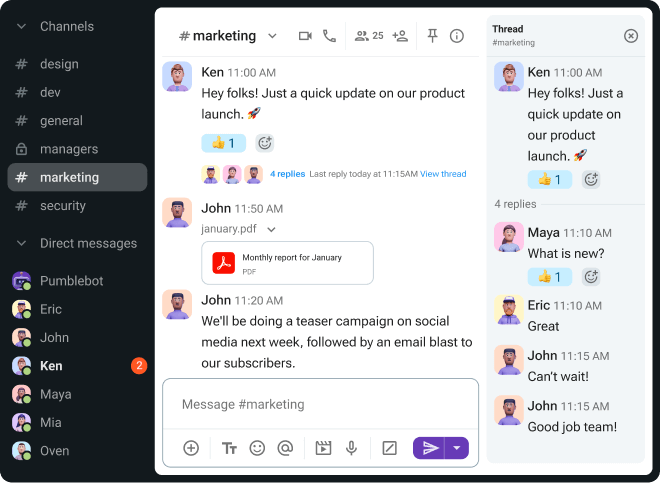
Pumble holds the essence of what Slack does well while eliminating its biggest downsides.
It is super easy to sign up, set up, and include others.
Pumble lets your team communicate and access the entire message history from the beginning for free.
What’s more, it is committed to keeping its core features free forever!
The paid plans are highly affordable, letting you make the most of the app without destroying your budget.
For $2.49 per user per month (billed annually), the Pumble PRO plan offers (along with features already included in the FREE plan):
- External access to calls,
- 10 GB of storage space per user,
- Group video and audio conferencing,
- Screen sharing, and
- Customizable sections.
The Pumble BUSINESS plan costs $3.99 per user per month, and it lets you:
- Have more storage space — 20 GB per user,
- Host more people in video and audio meetings (up to 100 participants),
- Record meetings,
- Collaborate with people outside your organization,
- Manage posting permissions,
- Create user groups, and
- Integrate Pumble with unlimited third-party apps.
The Pumble ENTERPRISE plan makes your workspace more secure and compliant with Single Sign-On and Data retention for $6.99 per user per month (billed annually). Plus, you’ll get 100 GB of storage space per user. This plan is especially suitable for legal, financial, and healthcare institutions.
Pumble has world-class priority customer support available 24 hours, every day of the week. You’re guaranteed a 99.99% uptime, which is an industry-leading standard for availability.
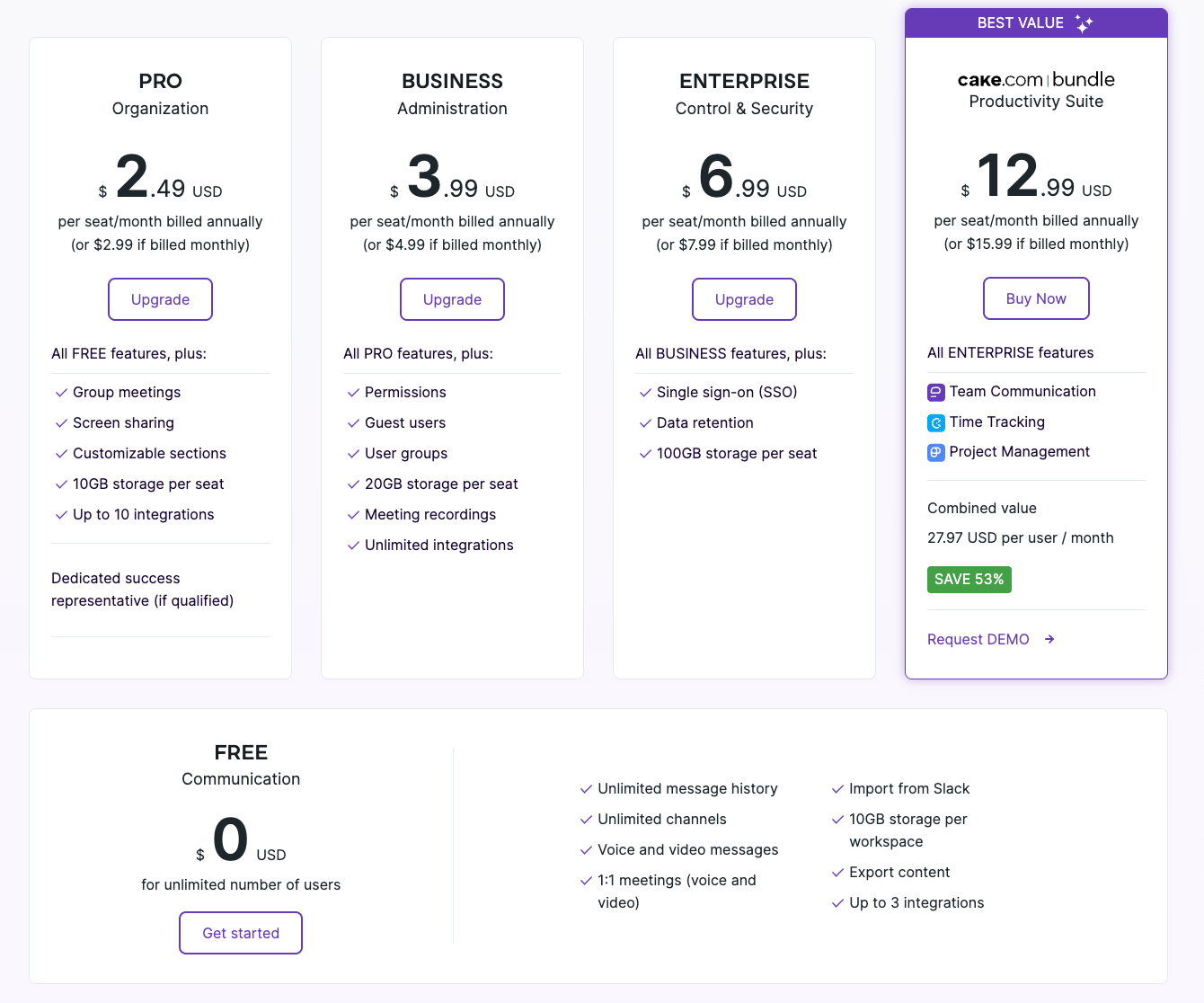
How do Slack and Pumble compare?
The main differences between Slack and Pumble are the cost-value ratio and message history.
Although Slack offers an extensive list of features, it’s hardly a great value for money.
Slack notoriously limits your message history and file storage to the most recent 90 days in the Free plan.
Pumble consistently offers more core value for less money.
Here’s a breakdown of how the two apps compare in main categories.
| Features | Slack | Pumble |
|---|---|---|
| Message history |
Limited to the recent 90 days in the Free plan |
Unlimited in the FREE plan |
| File storage |
Limited to the recent 90 days in the Free plan |
Starting from 10 GB in the FREE plan, no time limit |
| Pricing |
Starting from $7.25 per user per month (billed annually) |
Starting from $2.49 per user per month (billed annually) |
| Interface |
Confusing navigation bar |
User-friendly |
| Meeting recording |
Not available |
Available in the BUSINESS and ENTERPRISE plans |
According to existing Pumble users, the main reasons for switching from Slack to Pumble include:
- A better cost-value ratio,
- Unlimited free chat history,
- A simple, user-friendly approach to communication, and
- Trust built by previously using Clockify (a time tracker created by the same CAKE.com team).
So, to get a clearer picture of how the two apps compare in terms of the main criterion — cost-value ratio — let’s revisit our example from before.
Pumble can save you $476 per month (or 65.7%) with an annual subscription for a team of 100 members, compared to the Slack monthly cost for the same team size (the Pro plan, at $7.25 per month per user when billed annually). With Pumble, you’ll pay only $2.49 per user per month for the annual subscription, or $2.99 per user per month if billed monthly for the Pumble PRO plan.
Try Pumble instead of Slack
If keeping your chat history is critical for your project development, but you don’t want to spend a fortune on Slack’s paid plans to keep your entire team in sync, it might be time to consider switching to Pumble.
Pumble keeps the core of what you appreciate about Slack’s approach to team communication — minus the limiting restrictions.
Try Pumble, and experience:
- A more intuitive user interface — Pumble is easy to set up and use with a clean layout that lets you focus on the conversations, unlike Slack's navigation bar that leaves something to be desired.
- More affordable pricing — Starting from the FREE plan, Pumble consistently offers a better cost-value ratio. The BUSINESS plan in Pumble (at $3.99) costs almost half of the cheapest plan in Slack (Pro plan at $7.25 when billed annually).
- Unlimited message history — Access all your conversations and files no matter which plan you are on. Keep track of all decisions and access any file ever exchanged.
- Meeting recording — Record your Pumble meetings to keep everything on file and share recordings with your team. Let your teammates access the recordings at their convenience and promote asynchronous team communication.
Avoid time restrictions and extortionate rates — switch to Pumble and communicate freely, without compromise.
Start chatting with
your team
• Unlimited users
• Unlimited chat history
• Free forever
